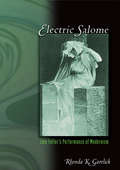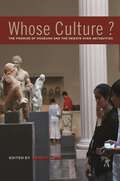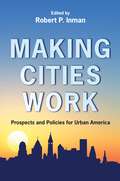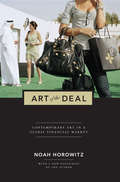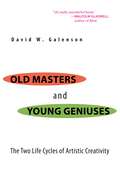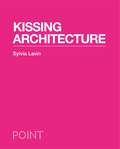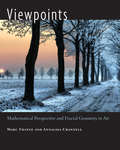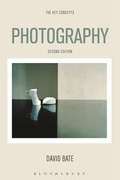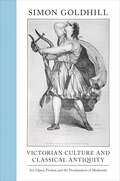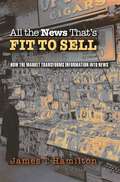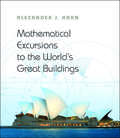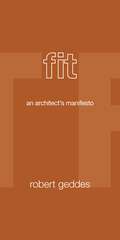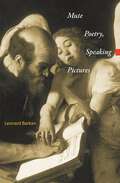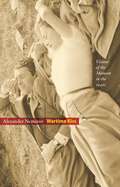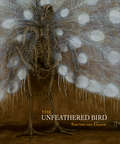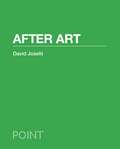- Table View
- List View
Electric Salome: Loie Fuller's Performance of Modernism
by Rhonda K. GarelickLoie Fuller was the most famous American in Europe throughout the late nineteenth and early twentieth centuries. Rising from a small-time vaudeville career in the States, she attained international celebrity as a dancer, inventor, impresario, and one of the first women filmmakers in the world. Fuller befriended royalty and inspired artists such as Mallarmé, Toulouse-Lautrec, Rodin, Sarah Bernhardt, and Isadora Duncan. Today, though, she is remembered mainly as an untutored "pioneer" of modern dance and stage technology, the "electricity fairy" who created a sensation onstage whirling under colored spotlights. But in Rhonda Garelick's Electric Salome, Fuller finally receives her due as a major artist whose work helped lay a foundation for all modernist performance to come. The book demonstrates that Fuller was not a mere entertainer or precursor, but an artist of great psychological, emotional, and sexual expressiveness whose work illuminates the centrality of dance to modernism. Electric Salome places Fuller in the context of classical and modern ballet, Art Nouveau, Orientalism, surrealism, the birth of cinema, American modern dance, and European drama. It offers detailed close readings of texts and performances, situated within broader historical, cultural, and theoretical frameworks. Accessibly written, the book also recounts the human story of how an obscure, uneducated woman from the dustbowl of the American Midwest moved to Paris, became a star, and lived openly for decades as a lesbian.
Whose Culture?: The Promise of Museums and the Debate over Antiquities
by James CunoThe international controversy over who "owns" antiquities has pitted museums against archaeologists and source countries where ancient artifacts are found. In his book Who Owns Antiquity?, James Cuno argued that antiquities are the cultural property of humankind, not of the countries that lay exclusive claim to them. Now in Whose Culture?, Cuno assembles preeminent museum directors, curators, and scholars to explain for themselves what's at stake in this struggle--and why the museums' critics couldn't be more wrong. Source countries and archaeologists favor tough cultural property laws restricting the export of antiquities, have fought for the return of artifacts from museums worldwide, and claim the acquisition of undocumented antiquities encourages looting of archaeological sites. In Whose Culture?, leading figures from universities and museums in the United States and Britain argue that modern nation-states have at best a dubious connection with the ancient cultures they claim to represent, and that archaeology has been misused by nationalistic identity politics. They explain why exhibition is essential to responsible acquisitions, why our shared art heritage trumps nationalist agendas, why restrictive cultural property laws put antiquities at risk from unstable governments--and more. Defending the principles of art as the legacy of all humankind and museums as instruments of inquiry and tolerance, Whose Culture? brings reasoned argument to an issue that for too long has been distorted by politics and emotionalism. In addition to the editor, the contributors are Kwame Anthony Appiah, Sir John Boardman, Michael F. Brown, Derek Gillman, Neil MacGregor, John Henry Merryman, Philippe de Montebello, David I. Owen, and James C. Y. Watt.
Whose Culture?: The Promise of Museums and the Debate over Antiquities
by James CunoThe international controversy over who "owns" antiquities has pitted museums against archaeologists and source countries where ancient artifacts are found. In his book Who Owns Antiquity?, James Cuno argued that antiquities are the cultural property of humankind, not of the countries that lay exclusive claim to them. Now in Whose Culture?, Cuno assembles preeminent museum directors, curators, and scholars to explain for themselves what's at stake in this struggle--and why the museums' critics couldn't be more wrong. Source countries and archaeologists favor tough cultural property laws restricting the export of antiquities, have fought for the return of artifacts from museums worldwide, and claim the acquisition of undocumented antiquities encourages looting of archaeological sites. In Whose Culture?, leading figures from universities and museums in the United States and Britain argue that modern nation-states have at best a dubious connection with the ancient cultures they claim to represent, and that archaeology has been misused by nationalistic identity politics. They explain why exhibition is essential to responsible acquisitions, why our shared art heritage trumps nationalist agendas, why restrictive cultural property laws put antiquities at risk from unstable governments--and more. Defending the principles of art as the legacy of all humankind and museums as instruments of inquiry and tolerance, Whose Culture? brings reasoned argument to an issue that for too long has been distorted by politics and emotionalism. In addition to the editor, the contributors are Kwame Anthony Appiah, Sir John Boardman, Michael F. Brown, Derek Gillman, Neil MacGregor, John Henry Merryman, Philippe de Montebello, David I. Owen, and James C. Y. Watt.
Making Cities Work: Prospects and Policies for Urban America
by Robert P. InmanMaking Cities Work brings together leading writers and scholars on urban America to offer critical perspectives on how to sustain prosperous, livable cities in today's fast-evolving economy. Successful cities provide jobs, quality schools, safe and clean neighborhoods, effective transportation, and welcoming spaces for all residents. But cities must be managed well if they are to remain attractive places to work, relax, and raise a family; otherwise residents, firms, and workers will leave and the social and economic advantages of city living will be lost. Drawing on cutting-edge research in the social sciences, the contributors explore optimal ways to manage the modern city and propose solutions to today's most pressing urban problems. Topics include the urban economy, transportation, housing and open space, immigration, race, the impacts of poverty on children, education, crime, and financing and managing services. The contributors show how to make cities work for diverse urban constituencies, and why we still need cities despite the many challenges they pose. Making Cities Work brings the latest findings in urban economics to policymakers, researchers, and students, as well as anyone interested in urban affairs. In addition to the editor, the contributors are David Card, Philip J. Cook, Janet Currie, Edward L. Glaeser, Joseph Gyourko, Richard J. Murnane, Witold Rybczynski, Kenneth A. Small, and Jacob L. Vigdor.
Art of the Deal: Contemporary Art in a Global Financial Market
by Noah HorowitzArt today is defined by its relationship to money as never before. Prices have been driven to unprecedented heights, conventional boundaries within the art world have collapsed, and artists think ever more strategically about how to advance their careers. Art is no longer simply made, but packaged, sold, and branded. In Art of the Deal, Noah Horowitz exposes the inner workings of the contemporary art market, explaining how this unique economy came to be, how it works, and where it's headed.In a new postscript, Horowitz reflects on the evolution of the trade since the book’s original release in 2011, shining light on the market’s continued ascent as well as its most urgent challenges.
Old Masters and Young Geniuses: The Two Life Cycles of Artistic Creativity
by David W. GalensonWhen in their lives do great artists produce their greatest art? Do they strive for creative perfection throughout decades of painstaking and frustrating experimentation, or do they achieve it confidently and decisively, through meticulous planning that yields masterpieces early in their lives? By examining the careers not only of great painters but also of important sculptors, poets, novelists, and movie directors, Old Masters and Young Geniuses offers a profound new understanding of artistic creativity. Using a wide range of evidence, David Galenson demonstrates that there are two fundamentally different approaches to innovation, and that each is associated with a distinct pattern of discovery over a lifetime. Experimental innovators work by trial and error, and arrive at their major contributions gradually, late in life. In contrast, conceptual innovators make sudden breakthroughs by formulating new ideas, usually at an early age. Galenson shows why such artists as Michelangelo, Rembrandt, Cézanne, Jackson Pollock, Virginia Woolf, Robert Frost, and Alfred Hitchcock were experimental old masters, and why Vermeer, van Gogh, Picasso, Herman Melville, James Joyce, Sylvia Plath, and Orson Welles were conceptual young geniuses. He also explains how this changes our understanding of art and its past. Experimental innovators seek, and conceptual innovators find. By illuminating the differences between them, this pioneering book provides vivid new insights into the mysterious processes of human creativity.
Old Masters and Young Geniuses: The Two Life Cycles of Artistic Creativity
by David W. GalensonWhen in their lives do great artists produce their greatest art? Do they strive for creative perfection throughout decades of painstaking and frustrating experimentation, or do they achieve it confidently and decisively, through meticulous planning that yields masterpieces early in their lives? By examining the careers not only of great painters but also of important sculptors, poets, novelists, and movie directors, Old Masters and Young Geniuses offers a profound new understanding of artistic creativity. Using a wide range of evidence, David Galenson demonstrates that there are two fundamentally different approaches to innovation, and that each is associated with a distinct pattern of discovery over a lifetime. Experimental innovators work by trial and error, and arrive at their major contributions gradually, late in life. In contrast, conceptual innovators make sudden breakthroughs by formulating new ideas, usually at an early age. Galenson shows why such artists as Michelangelo, Rembrandt, Cézanne, Jackson Pollock, Virginia Woolf, Robert Frost, and Alfred Hitchcock were experimental old masters, and why Vermeer, van Gogh, Picasso, Herman Melville, James Joyce, Sylvia Plath, and Orson Welles were conceptual young geniuses. He also explains how this changes our understanding of art and its past. Experimental innovators seek, and conceptual innovators find. By illuminating the differences between them, this pioneering book provides vivid new insights into the mysterious processes of human creativity.
Kissing Architecture
by Sylvia LavinKissing Architecture explores the mutual attraction between architecture and other forms of contemporary art. In this fresh, insightful, and beautifully illustrated book, renowned architectural critic and scholar Sylvia Lavin develops the concept of "kissing" to describe the growing intimacy between architecture and new types of art--particularly multimedia installations that take place in and on the surfaces of buildings--and to capture the sensual charge that is being designed and built into architectural surfaces and interior spaces today. Initiating readers into the guilty pleasures of architecture that abandons the narrow focus on function, Lavin looks at recent work by Pipilotti Rist, Doug Aitken, the firm Diller Scofidio + Renfro, and others who choose instead to embrace the viewer in powerful affects and visual and sensory atmospheres. Kissing Architecture is the first book in a cutting-edge new series of short, focused arguments written by leading critics, historians, theorists, and practitioners from the world of urban development and contemporary architecture and design. These books are intended to spark vigorous debate. They stake out the positions that will help shape the architecture and urbanism of tomorrow. Addressing one of the most spectacular and significant developments in the current cultural scene, Kissing Architecture is an entertainingly irreverent and disarmingly incisive book that offers an entirely new way of seeing--and experiencing--architecture in the age after representation.
Kissing Architecture
by Sylvia LavinKissing Architecture explores the mutual attraction between architecture and other forms of contemporary art. In this fresh, insightful, and beautifully illustrated book, renowned architectural critic and scholar Sylvia Lavin develops the concept of "kissing" to describe the growing intimacy between architecture and new types of art--particularly multimedia installations that take place in and on the surfaces of buildings--and to capture the sensual charge that is being designed and built into architectural surfaces and interior spaces today. Initiating readers into the guilty pleasures of architecture that abandons the narrow focus on function, Lavin looks at recent work by Pipilotti Rist, Doug Aitken, the firm Diller Scofidio + Renfro, and others who choose instead to embrace the viewer in powerful affects and visual and sensory atmospheres. Kissing Architecture is the first book in a cutting-edge new series of short, focused arguments written by leading critics, historians, theorists, and practitioners from the world of urban development and contemporary architecture and design. These books are intended to spark vigorous debate. They stake out the positions that will help shape the architecture and urbanism of tomorrow. Addressing one of the most spectacular and significant developments in the current cultural scene, Kissing Architecture is an entertainingly irreverent and disarmingly incisive book that offers an entirely new way of seeing--and experiencing--architecture in the age after representation.
Viewpoints: Mathematical Perspective and Fractal Geometry in Art
by Marc Frantz Annalisa CrannellAn undergraduate textbook devoted exclusively to relationships between mathematics and art, Viewpoints is ideally suited for math-for-liberal-arts courses and mathematics courses for fine arts majors. The textbook contains a wide variety of classroom-tested activities and problems, a series of essays by contemporary artists written especially for the book, and a plethora of pedagogical and learning opportunities for instructors and students. Viewpoints focuses on two mathematical areas: perspective related to drawing man-made forms and fractal geometry related to drawing natural forms. Investigating facets of the three-dimensional world in order to understand mathematical concepts behind the art, the textbook explores art topics including comic, anamorphic, and classical art, as well as photography, while presenting such mathematical ideas as proportion, ratio, self-similarity, exponents, and logarithms. Straightforward problems and rewarding solutions empower students to make accurate, sophisticated drawings. Personal essays and short biographies by contemporary artists are interspersed between chapters and are accompanied by images of their work. These fine artists--who include mathematicians and scientists--examine how mathematics influences their art. Accessible to students of all levels, Viewpoints encourages experimentation and collaboration, and captures the essence of artistic and mathematical creation and discovery. Classroom-tested activities and problem solving Accessible problems that move beyond regular art school curriculum Multiple solutions of varying difficulty and applicability Appropriate for students of all mathematics and art levels Original and exclusive essays by contemporary artists Forthcoming: Instructor's manual (available only to teachers)
Viewpoints: Mathematical Perspective and Fractal Geometry in Art
by Marc Frantz Annalisa CrannellAn undergraduate textbook devoted exclusively to relationships between mathematics and art, Viewpoints is ideally suited for math-for-liberal-arts courses and mathematics courses for fine arts majors. The textbook contains a wide variety of classroom-tested activities and problems, a series of essays by contemporary artists written especially for the book, and a plethora of pedagogical and learning opportunities for instructors and students. Viewpoints focuses on two mathematical areas: perspective related to drawing man-made forms and fractal geometry related to drawing natural forms. Investigating facets of the three-dimensional world in order to understand mathematical concepts behind the art, the textbook explores art topics including comic, anamorphic, and classical art, as well as photography, while presenting such mathematical ideas as proportion, ratio, self-similarity, exponents, and logarithms. Straightforward problems and rewarding solutions empower students to make accurate, sophisticated drawings. Personal essays and short biographies by contemporary artists are interspersed between chapters and are accompanied by images of their work. These fine artists--who include mathematicians and scientists--examine how mathematics influences their art. Accessible to students of all levels, Viewpoints encourages experimentation and collaboration, and captures the essence of artistic and mathematical creation and discovery. Classroom-tested activities and problem solving Accessible problems that move beyond regular art school curriculum Multiple solutions of varying difficulty and applicability Appropriate for students of all mathematics and art levels Original and exclusive essays by contemporary artists Forthcoming: Instructor's manual (available only to teachers)
Photography: The Key Concepts, (2nd edition) (PDF)
by David BateProviding a thorough and comprehensive introduction to the study of photography, this second edition of Photography: The Key Concepts has been expanded and updated to cover more fully contemporary changes to photography. Photography is a part of everyday life; from news and advertisements, to data collection and surveillance, to the shaping of personal and social identity, we are constantly surrounded by the photographic image. Outlining an overview of photographic genres, David Bate explores how these varied practices can be coded and interpreted using key theoretical models. Building upon the genres included in the first edition - documentary, portraiture, landscape, still life, art and global photography - this second edition includes two new chapters on snapshots and the act of looking. The revised and expanded chapters are supported by over three times as many photographs as in the first edition, examining contemporary practices in more detail and equipping students with the analytical skills they need, both in their academic studies and in their own practical work. An indispensable guide to the field, Photography: The Key Concepts is core reading for all courses that consider the place of photography in society, within photographic practice, visual culture, art, media and cultural studies.
Victorian Culture and Classical Antiquity: Art, Opera, Fiction, and the Proclamation of Modernity
by Simon GoldhillHow did the Victorians engage with the ancient world? Victorian Culture and Classical Antiquity is a brilliant exploration of how the ancient worlds of Greece and Rome influenced Victorian culture. Through Victorian art, opera, and novels, Simon Goldhill examines how sexuality and desire, the politics of culture, and the role of religion in society were considered and debated through the Victorian obsession with antiquity. Looking at Victorian art, Goldhill demonstrates how desire and sexuality, particularly anxieties about male desire, were represented and communicated through classical imagery. Probing into operas of the period, Goldhill addresses ideas of citizenship, nationalism, and cultural politics. And through fiction--specifically nineteenth-century novels about the Roman Empire--he discusses religion and the fierce battles over the church as Christianity began to lose dominance over the progressive stance of Victorian science and investigation. Rediscovering some great forgotten works and reframing some more familiar ones, the book offers extraordinary insights into how the Victorian sense of antiquity and our sense of the Victorians came into being. With a wide range of examples and stories, Victorian Culture and Classical Antiquity demonstrates how interest in the classical past shaped nineteenth-century self-expression, giving antiquity a unique place in Victorian culture.
Victorian Culture and Classical Antiquity: Art, Opera, Fiction, and the Proclamation of Modernity
by Simon GoldhillHow did the Victorians engage with the ancient world? Victorian Culture and Classical Antiquity is a brilliant exploration of how the ancient worlds of Greece and Rome influenced Victorian culture. Through Victorian art, opera, and novels, Simon Goldhill examines how sexuality and desire, the politics of culture, and the role of religion in society were considered and debated through the Victorian obsession with antiquity. Looking at Victorian art, Goldhill demonstrates how desire and sexuality, particularly anxieties about male desire, were represented and communicated through classical imagery. Probing into operas of the period, Goldhill addresses ideas of citizenship, nationalism, and cultural politics. And through fiction--specifically nineteenth-century novels about the Roman Empire--he discusses religion and the fierce battles over the church as Christianity began to lose dominance over the progressive stance of Victorian science and investigation. Rediscovering some great forgotten works and reframing some more familiar ones, the book offers extraordinary insights into how the Victorian sense of antiquity and our sense of the Victorians came into being. With a wide range of examples and stories, Victorian Culture and Classical Antiquity demonstrates how interest in the classical past shaped nineteenth-century self-expression, giving antiquity a unique place in Victorian culture.
All the News That’s Fit to Sell: How the Market Transforms Information into News
by James T. HamiltonThat market forces drive the news is not news. Whether a story appears in print, on television, or on the Internet depends on who is interested, its value to advertisers, the costs of assembling the details, and competitors' products. But in All the News That's Fit to Sell, economist James Hamilton shows just how this happens. Furthermore, many complaints about journalism--media bias, soft news, and pundits as celebrities--arise from the impact of this economic logic on news judgments. This is the first book to develop an economic theory of news, analyze evidence across a wide range of media markets on how incentives affect news content, and offer policy conclusions. Media bias, for instance, was long a staple of the news. Hamilton's analysis of newspapers from 1870 to 1900 reveals how nonpartisan reporting became the norm. A hundred years later, some partisan elements reemerged as, for example, evening news broadcasts tried to retain young female viewers with stories aimed at their (Democratic) political interests. Examination of story selection on the network evening news programs from 1969 to 1998 shows how cable competition, deregulation, and ownership changes encouraged a shift from hard news about politics toward more soft news about entertainers. Hamilton concludes by calling for lower costs of access to government information, a greater role for nonprofits in funding journalism, the development of norms that stress hard news reporting, and the defining of digital and Internet property rights to encourage the flow of news. Ultimately, this book shows that by more fully understanding the economics behind the news, we will be better positioned to ensure that the news serves the public good.
All the News That’s Fit to Sell: How the Market Transforms Information into News (PDF)
by James T. HamiltonThat market forces drive the news is not news. Whether a story appears in print, on television, or on the Internet depends on who is interested, its value to advertisers, the costs of assembling the details, and competitors' products. But in All the News That's Fit to Sell, economist James Hamilton shows just how this happens. Furthermore, many complaints about journalism--media bias, soft news, and pundits as celebrities--arise from the impact of this economic logic on news judgments. This is the first book to develop an economic theory of news, analyze evidence across a wide range of media markets on how incentives affect news content, and offer policy conclusions. Media bias, for instance, was long a staple of the news. Hamilton's analysis of newspapers from 1870 to 1900 reveals how nonpartisan reporting became the norm. A hundred years later, some partisan elements reemerged as, for example, evening news broadcasts tried to retain young female viewers with stories aimed at their (Democratic) political interests. Examination of story selection on the network evening news programs from 1969 to 1998 shows how cable competition, deregulation, and ownership changes encouraged a shift from hard news about politics toward more soft news about entertainers. Hamilton concludes by calling for lower costs of access to government information, a greater role for nonprofits in funding journalism, the development of norms that stress hard news reporting, and the defining of digital and Internet property rights to encourage the flow of news. Ultimately, this book shows that by more fully understanding the economics behind the news, we will be better positioned to ensure that the news serves the public good.
Mathematical Excursions to the World's Great Buildings
by Alexander J. HahnFrom the pyramids and the Parthenon to the Sydney Opera House and the Bilbao Guggenheim, this book takes readers on an eye-opening tour of the mathematics behind some of the world's most spectacular buildings. Beautifully illustrated, the book explores the milestones in elementary mathematics that enliven the understanding of these buildings and combines this with an in-depth look at their aesthetics, history, and structure. Whether using trigonometry and vectors to explain why Gothic arches are structurally superior to Roman arches, or showing how simple ruler and compass constructions can produce sophisticated architectural details, Alexander Hahn describes the points at which elementary mathematics and architecture intersect. Beginning in prehistoric times, Hahn proceeds to guide readers through the Greek, Roman, Islamic, Romanesque, Gothic, Renaissance, and modern styles. He explores the unique features of the Pantheon, the Hagia Sophia, the Great Mosque of Cordoba, the Duomo in Florence, Palladio's villas, and Saint Peter's Basilica, as well as the U.S. Capitol Building. Hahn celebrates the forms and structures of architecture made possible by mathematical achievements from Greek geometry, the Hindu-Arabic number system, two- and three-dimensional coordinate geometry, and calculus. Along the way, Hahn introduces groundbreaking architects, including Brunelleschi, Alberti, da Vinci, Bramante, Michelangelo, della Porta, Wren, Gaudí, Saarinen, Utzon, and Gehry. Rich in detail, this book takes readers on an expedition around the globe, providing a deeper understanding of the mathematical forces at play in the world's most elegant buildings.
Fit: An Architect's Manifesto
by Robert GeddesFit is a book about architecture and society that seeks to fundamentally change how architects and the public think about the task of design. Distinguished architect and urbanist Robert Geddes argues that buildings, landscapes, and cities should be designed to fit: fit the purpose, fit the place, fit future possibilities. Fit replaces old paradigms, such as form follows function, and less is more, by recognizing that the relationship between architecture and society is a true dialogue--dynamic, complex, and, if carried out with knowledge and skill, richly rewarding. With a tip of the hat to John Dewey, Fit explores architecture as we experience it. Geddes starts with questions: Why do we design where we live and work? Why do we not just live in nature, or in chaos? Why does society care about architecture? Why does it really matter? Fit answers these questions through a fresh examination of the basic purposes and elements of architecture--beginning in nature, combining function and expression, and leaving a legacy of form. Lively, charming, and gently persuasive, the book shows brilliant examples of fit: from Thomas Jefferson's University of Virginia and Louis Kahn's Exeter Library to contemporary triumphs such as the Apple Store on New York's Fifth Avenue, Chicago's Millennium Park, and Seattle's Pike Place. Fit is a book for everyone, because we all live in constructions--buildings, landscapes, and, increasingly, cities. It provokes architects and planners, humanists and scientists, civic leaders and citizens to reconsider what is at stake in architecture--and why it delights us.
Fit: An Architect's Manifesto
by Robert GeddesFit is a book about architecture and society that seeks to fundamentally change how architects and the public think about the task of design. Distinguished architect and urbanist Robert Geddes argues that buildings, landscapes, and cities should be designed to fit: fit the purpose, fit the place, fit future possibilities. Fit replaces old paradigms, such as form follows function, and less is more, by recognizing that the relationship between architecture and society is a true dialogue--dynamic, complex, and, if carried out with knowledge and skill, richly rewarding. With a tip of the hat to John Dewey, Fit explores architecture as we experience it. Geddes starts with questions: Why do we design where we live and work? Why do we not just live in nature, or in chaos? Why does society care about architecture? Why does it really matter? Fit answers these questions through a fresh examination of the basic purposes and elements of architecture--beginning in nature, combining function and expression, and leaving a legacy of form. Lively, charming, and gently persuasive, the book shows brilliant examples of fit: from Thomas Jefferson's University of Virginia and Louis Kahn's Exeter Library to contemporary triumphs such as the Apple Store on New York's Fifth Avenue, Chicago's Millennium Park, and Seattle's Pike Place. Fit is a book for everyone, because we all live in constructions--buildings, landscapes, and, increasingly, cities. It provokes architects and planners, humanists and scientists, civic leaders and citizens to reconsider what is at stake in architecture--and why it delights us.
Mute Poetry, Speaking Pictures
by Leonard BarkanWhy do painters sometimes wish they were poets--and why do poets sometimes wish they were painters? What happens when Rembrandt spells out Hebrew in the sky or Poussin spells out Latin on a tombstone? What happens when Virgil, Ovid, or Shakespeare suspend their plots to describe a fictitious painting? In Mute Poetry, Speaking Pictures, Leonard Barkan explores such questions as he examines the deliciously ambiguous history of the relationship between words and pictures, focusing on the period from antiquity to the Renaissance but offering insights that also have much to say about modern art and literature. The idea that a poem is like a picture has been a commonplace since at least ancient Greece, and writers and artists have frequently discussed poetry by discussing painting, and vice versa, but their efforts raise more questions than they answer. From Plutarch ("painting is mute poetry, poetry a speaking picture") to Horace ("as a picture, so a poem"), apparent clarity quickly leads to confusion about, for example, what qualities of pictures are being urged upon poets or how pictorial properties can be converted into poetical ones. The history of comparing and contrasting painting and poetry turns out to be partly a story of attempts to promote one medium at the expense of the other. At the same time, analogies between word and image have enabled writers and painters to think about and practice their craft. Ultimately, Barkan argues, this dialogue is an expression of desire: the painter longs for the rich signification of language while the poet yearns for the direct sensuousness of painting.
Mute Poetry, Speaking Pictures
by Leonard BarkanWhy do painters sometimes wish they were poets--and why do poets sometimes wish they were painters? What happens when Rembrandt spells out Hebrew in the sky or Poussin spells out Latin on a tombstone? What happens when Virgil, Ovid, or Shakespeare suspend their plots to describe a fictitious painting? In Mute Poetry, Speaking Pictures, Leonard Barkan explores such questions as he examines the deliciously ambiguous history of the relationship between words and pictures, focusing on the period from antiquity to the Renaissance but offering insights that also have much to say about modern art and literature. The idea that a poem is like a picture has been a commonplace since at least ancient Greece, and writers and artists have frequently discussed poetry by discussing painting, and vice versa, but their efforts raise more questions than they answer. From Plutarch ("painting is mute poetry, poetry a speaking picture") to Horace ("as a picture, so a poem"), apparent clarity quickly leads to confusion about, for example, what qualities of pictures are being urged upon poets or how pictorial properties can be converted into poetical ones. The history of comparing and contrasting painting and poetry turns out to be partly a story of attempts to promote one medium at the expense of the other. At the same time, analogies between word and image have enabled writers and painters to think about and practice their craft. Ultimately, Barkan argues, this dialogue is an expression of desire: the painter longs for the rich signification of language while the poet yearns for the direct sensuousness of painting.
Wartime Kiss: Visions of the Moment in the 1940s
by Alexander NemerovWartime Kiss is a personal meditation on the haunting power of American photographs and films from World War II and the later 1940s. Starting with a stunning reinterpretation of one of the most famous photos of all time, Alfred Eisenstaedt's image of a sailor kissing a nurse in Times Square on V-J Day, Alexander Nemerov goes on to examine an array of mostly forgotten images and movie episodes--from a photo of Jimmy Stewart and Olivia de Havilland lying on a picnic blanket in the Santa Barbara hills to scenes from such films as Twelve O'Clock High and Hold Back the Dawn. Erotically charged and bearing traces of trauma even when they seem far removed from the war, these photos and scenes seem to hold out the promise of a palpable and emotional connection to those years. Through a series of fascinating stories, Nemerov reveals the surprising background of these bits of film and discovers unexpected connections between the war and Hollywood, from an obsession with aviation to Anne Frank's love of the movies. Beautifully written and illustrated, Wartime Kiss vividly evokes a world in which Margaret Bourke-White could follow a heroic assignment photographing a B-17 bombing mission over Tunis with a job in Hollywood documenting the filming of a war movie. Ultimately this is a book about history as a sensuous experience, a work as mysterious, indescribable, and affecting as a novel by W. G. Sebald.
Wartime Kiss: Visions of the Moment in the 1940s
by Alexander NemerovWartime Kiss is a personal meditation on the haunting power of American photographs and films from World War II and the later 1940s. Starting with a stunning reinterpretation of one of the most famous photos of all time, Alfred Eisenstaedt's image of a sailor kissing a nurse in Times Square on V-J Day, Alexander Nemerov goes on to examine an array of mostly forgotten images and movie episodes--from a photo of Jimmy Stewart and Olivia de Havilland lying on a picnic blanket in the Santa Barbara hills to scenes from such films as Twelve O'Clock High and Hold Back the Dawn. Erotically charged and bearing traces of trauma even when they seem far removed from the war, these photos and scenes seem to hold out the promise of a palpable and emotional connection to those years. Through a series of fascinating stories, Nemerov reveals the surprising background of these bits of film and discovers unexpected connections between the war and Hollywood, from an obsession with aviation to Anne Frank's love of the movies. Beautifully written and illustrated, Wartime Kiss vividly evokes a world in which Margaret Bourke-White could follow a heroic assignment photographing a B-17 bombing mission over Tunis with a job in Hollywood documenting the filming of a war movie. Ultimately this is a book about history as a sensuous experience, a work as mysterious, indescribable, and affecting as a novel by W. G. Sebald.
The Unfeathered Bird
by Katrina Van GrouwThere is more to a bird than simply feathers. And just because birds evolved from a single flying ancestor doesn't mean they are structurally all the same. With over 385 stunning drawings depicting 200 species, The Unfeathered Bird is a richly illustrated book on bird anatomy that offers refreshingly original insights into what goes on beneath the feathered surface. Each exquisite drawing is made from an actual specimen and reproduced in sumptuous large format. The birds are shown in lifelike positions and engaged in behavior typical of the species: an underwater view of the skeleton of a swimming loon, the musculature of a porpoising penguin, and an unfeathered sparrowhawk plucking its prey. Jargon-free and easily accessible to any reader, the lively text relates birds' anatomy to their lifestyle and evolution, examining such questions as why penguins are bigger than auks, whether harrier hawks really have double-jointed legs, and the difference between wing claws and wing spurs. A landmark in popular bird books, The Unfeathered Bird is a must for anyone who appreciates birds or bird art. A unique book that bridges art, science, and history Over 385 beautiful drawings, artistically arranged in a sumptuous large-format book Accessible, jargon-free text--the only book on bird anatomy aimed at the general reader Drawings and text all based on actual bird specimens Includes most anatomically distinct bird groups Many species never illustrated before
After Art
by David JoselitArt as we know it is dramatically changing, but popular and critical responses lag behind. In this trenchant illustrated essay, David Joselit describes how art and architecture are being transformed in the age of Google. Under the dual pressures of digital technology, which allows images to be reformatted and disseminated effortlessly, and the exponential acceleration of cultural exchange enabled by globalization, artists and architects are emphasizing networks as never before. Some of the most interesting contemporary work in both fields is now based on visualizing patterns of dissemination after objects and structures are produced, and after they enter into, and even establish, diverse networks. Behaving like human search engines, artists and architects sort, capture, and reformat existing content. Works of art crystallize out of populations of images, and buildings emerge out of the dynamics of the circulation patterns they will house. Examining the work of architectural firms such as OMA, Reiser + Umemoto, and Foreign Office, as well as the art of Matthew Barney, Ai Weiwei, Sherrie Levine, and many others, After Art provides a compelling and original theory of art and architecture in the age of global networks.
